考古学怎样告诉我们关于保罗在居比路的行程(徒十三4-12)?
作者:David W.J. Gill
张逸萍译自:https://www.christiananswers.net/q-abr/abr-a020.html
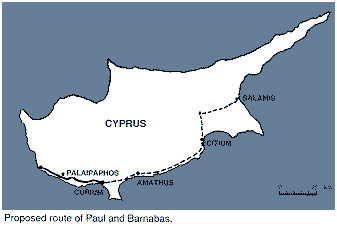
序言
保罗和巴拿巴从海路抵居比路(今天的塞浦路斯)的撒拉米之前,“经过全岛,直到帕弗”(徒十三6)。他们行程的其他时候,似乎都是利用罗马建造的道路网络。因此,离开居比路之后,到彼西底的安提阿的途中,保罗走的是亚古士督在主前6年建造的通过Sebaste的路。[1] 在马其顿,经过Egnatia,作为从尼亚波利向西的路线。[2]
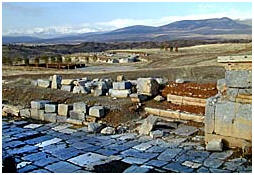 |
|
保罗和巴拿巴向彼西底的安提阿走,路上的废墟。 Photo
provided by ChristianAnswers Associate, BiblePlaces. |
居比路的行程把他们从居比路东岸带到西部。这么讲,可能显示这条路是通过岛上一些最重要的城市。但是,首先要了解这个省份的发展。
这省是在主前58年(Badian 1965)获得的,虽然居比路早些时已被认为是“罗马的朋友和同盟”之一。[3] 最初它成为罗马的基利家省的附属地[4]。在主前48/7,该岛回到埃及的控制之下。主前31年,克利欧佩特拉(Cleopatra)的死,使居比路又回到了罗马统治之下。随后在主前22年,亚古士督使居比路成为在方伯御营地位下的长老省之一。岛上没有罗马殖民地。
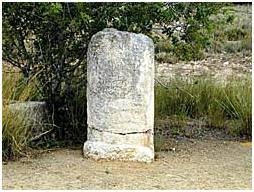 |
|
一个罗马里程碑 Photo
provided by ChristianAnswers Associate, BiblePlaces. |
罗马居比路的道路
有两个证据可以显示撒拉米和帕弗之间有一条路∶首先是罗马路线;其次是里程碑。列出路线和其间距离的“波伊廷格地地图”(Peutinger Table)显示,可能有两条道开始於撒拉米(Miller 1916∶827-29)。第一条路沿北岸的Kyrenia山脊上,向西北方到Chytri,然后沿著海岸前往Soli,Arsinoe(Marion),然后向南到帕弗。第二条路从南岸向Citium走,向西到Amathus,Curium,然后到帕弗。这些路线不是当代的,可能经过一段时间的形成的。距离可表列如下
∶|
撒拉米 --
Tremithus |
18 英里 |
总共有115英里。[5] 通过北部海岸的另一条路则更长:从撒拉米到
Soli,是88英里(或通经过Tremithus,是 71英里),然后经过Arsinoe再到帕弗,54英里,总共142英里。[6] 城市之间的距离也适合一天的旅程。这样,从岛的一端到另一端至少要六天的旅程。[7]幸存下来的里程碑是最好的资料,可以决定这些路线的年代,它们经常有皇帝的名字(Mitford
1980∶1333-35,n 213)。这些碑大部分都属于四世纪,而且很可能属于一段修理道路系统的时期,而不是扩张的时间。保罗和巴拿巴的旅程,至少在南岸,因有亚古士督统治期间所建造的罗马公路,才能让他们能成行。可见于离帕弗11里(罗马),朝向Curium的一个里程碑(Mitford
1966:98-99 no. 3)。[8] 它写著说∶
[imp.ca]ESAR AVG[vstvs]
[divif.]PONTIF[ex
max.]
[trib.potest.-cos.-]
因为亚古士督被称为
pontifex maximus,所以该工程必然在主前12年之后进行。[9] 虽然碑文只能确定帕弗和Curium之间有路,它可能向东延伸到撒拉米。下一个重大的发展是在Titus统治的81年七月至九月期间,[12] 在全省建设“新路”。 ([via]s novas; Corpus inscriptionum latinarumIII.6732)10] [11] 一个里程碑指出一条新路,从撒拉米向东北,到Agios Theodoros,又从那里到达据推测是Carpasia的地方。[13] 在Flavian时期建造的其他道路,大概是亚古士督计划的延伸。Mitford认为,横过居比路中部,从Soli到撒拉米的路线,就是这些建筑之一(1980∶1336)。下一个主要的碑文系列,来自
Severan时期。[14] 由于其中一些是沿著从帕弗到Curium的路旁被发现的,显然这是修理工作的一部分。然而,正是从这个时期开始,有明确的迹象,显示有一条路,从Soli到Arsinoe,然后向南到帕弗。[15]鉴于这些证据,我们认为,保罗和巴拿巴的最简单路线,就是从撒拉米,沿著南部海岸走。
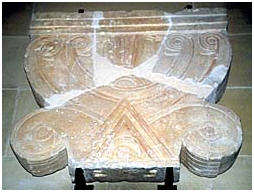 |
|
居比路7世纪的最初首都Aeolic。Photo provided by ChristianAnswers Associate, BiblePlaces. |
保罗和巴拿巴到访过的城市
保罗和巴拿巴到访居比路时,使徒行传中曾提到的城市,只有撒拉米和帕弗。然而,如果保罗和巴拿巴沿著南海岸的亚古士督路步行,[16] 在到达帕弗之前,他们会经过Citium,Amathus和Curium。[17]
由于公众寺院的名望,其中三个城市在公元22年获得了庇护权,[18] 就是撒拉米(Olympian
Zeus; Mitford 1990∶2189-90),Amathus(Aphrodite;
Mitford 1990∶2185)和帕弗(Paphian
Aphrodite)。应该指出的是,虽然这些神明听起来好像拟人的奥林匹克神[希腊神话],其实有一些比较有区域的味道。例如,Paphian
Aphrodite是一块圣石(或baetyl[译按:有神圣来源而被膜拜的粗糙的石头(如陨石)]),而不是一个女神的雕像。[19]
(译按:Aphrodite通常翻译为“爱芙罗黛蒂希腊女神”。)
Amathus
附近记录了类似的圣石膜拜。在Amathus附近的Agios Tychon发现了一个记录“居比路女神”(Cyprian Aphrodite)的碑文,和“the Seven within the Stelai”的祭坊(Mitford 1980: 1302, no. 28; 1946: 40-42, no. 16)。[20] 是由罗马居比路巡抚L. Bruttius Maximus举行奉献礼的(79/80)。据推测,这个祭坊有一个中央的baetyl,周围有其他圣石。在东方,膜拜圣石,并不罕见。特别是著名的是被Elagabalus带到罗马的Emaesa Baetyl [21] ,或者在Perge的人,对Artemis神的膜拜 (Butcher 1988: 90, fig. 6.114)。Paphian
女神的祭坊与皇帝的膜拜有关;对皇帝的膜拜与在Palaipaphos的女神祭坊也有关。例如, Livia被确定为新的女神(Gardner, Hogarth and James 1888: 242, no. 61),亚古士督的女儿Julia,就是Augusta (Inscriptiones Graecae ad Res Romanas Pertinentes III.940)。其他与皇帝膜拜有关的铭文,包括对Amyntor儿子Lysias的敬称:“皇室生活福乐的大祭司” (Mitford 1990: 2197)。
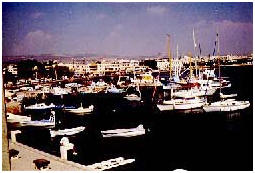 |
|
保罗登陆的居比路港口帕弗。 |
撒拉米和帕弗,是岛上最重要的两个城市。帕弗是省政府的所在地 (Mitford 1980: 1309-15)。就在这里,保罗遇到岛上的方伯士求保罗。[22] 帕弗建于主前312年左右,以取代Palaipaphos。主前二世纪时,它似乎已经成为岛上的主要城市,突破了撒拉米的地位。[23]
这座城市在主前15年被地震破坏,亚古士督随后给这城市Augusta的头衔(Mitford 1980: 1310, 有头衔的细节)。这个城市还得到其他的荣誉,也许在尼禄(Nero)时,它得到Claudia的额外头衔(Mitford 1980: 1310)。
[24]帕弗在罗马事务中的核心地位,可见于里程碑标记和它之间的距离。其他城市中,Citium保留了早期腓尼基人过去的味道(Mitford
1980: 1318-20)。早期腓尼基的Eshmun膜拜,成为Asclepius[译按:希腊神医]的膜拜,在亚古士督之下活跃(Mitford
1980:1319)。主前一世纪的膜拜对象之一,或亚古士督的高级祭司的捐助人,有一个名字,叫做Asclepiodotus的儿子Asclepiodotus,这揭示了他与Asclepius的联系。[25]
在这个城市的另一处,有一个拱廊,于主前41年献给Zeus Keraunios、神圣的Julius、女神 (Corpus Inscriptionum Graecarum 2641; Mitford 1990: 2195)。Amathus也有一个重要的,膜拜Hera的地点,当然在Claudian时期活跃的(Inscriptiones Graecae ad Res Romanas Pertinentes III.974)。[26]
在卫城上发现了一个献给亚古士督的祭坛(Inscriptiones Graecae ad Res Romanas Pertinentes III.973)。位于城市西边的Apollo Hylates的祭坊,可能是同时建设的。
总而言之,保罗和巴拿巴经过居比路的路线,把他们带到岛上几个重要的城市,其中包括三个获得庇护权的特殊地位的。行程表明,需时一个星期。这条路让他们接触到一些主要的膜拜中心,例如Palaipapos的女神祭坊,也把他们带到在帕弗,就是该岛的罗马政府核心。
更多网上资料
注释
The inscription is dated to AD 50, see
Mitford 1990: 2185. For details of Amathus, see Mitford 1980:
1315-17.
-
Badian, E. 1965 M. Porcius Cato and the Annexation and Early Administration of Cyprus.Journal of Roman Studies 55:110-21.
-
Butcher, K. 1988 Roman Provincial Coins: An Introduction to the “Greek Imperials.”London: Seaby.
-
French, D.H. 1980 “The Roman Road System of Asia Minor”. Pp. 698-729 in Aufstieg und Niedergang der r’mischen Welt II.7.2, eds. H. Temporini and W. Haase. Berlin.
-
1988 “Roman Roads and Milestones of Asia Minor”, fasc. 2: An Interim Catalogue of Milestones, British Archaeological Reports International Series 392, British Institute of Archaeology at Ankara monograph 9. Oxford: BAR.
-
1994 Acts and the Roman Roads of Asia Minor. Pp. 49-58 in The Book of Acts in its Graeco-Roman Setting, The Book of Acts in its First Century Setting 2, eds. D.W.J. Gill and C. Gemp. Grand Rapids: Eerdmans.
-
Gill, D.W.J. 1994 Macedonia. In The Book of Acts in its Graeco-Roman Setting, The Book of Acts in its First Century Setting 2, eds. D.W.J. Gill and C. Gemp. Grand Rapids: Eerdmans.
-
Jones, A.H.M. 1971 The Cities of the Eastern Roman Empire (2nd ed.). Oxford: Clarendon Press.
-
Millar, F. 1993 The Roman Near East 31 BC-AD 337. Cambridge MA: Harvard University Press.
-
Miller, K. [1916] 1964 Itineraria Romana. Reprint. Rome: L’Erma di Bretschneider.
-
Mitchell, S. 1993 Anatolia: Land, Men and Gods in Asia Minor 1: The Celts and Impact of Roman Rule. Oxford: Clarendon Press.
-
Mitford, T.B. 1939 “Milestones in Western Cyprus”. Journal of Roman Studies 29.
1946 “Religious Documents from Roman Cyprus”. Journal of Hellenic Studies 66.
1961 “Further Contributions to the Epigraphy of Cyprus”. American Journal of Archaeology 65.
1966 “Three Milestones of Western Cyprus”. American Journal of Archaeology 70.
1980 “Roman Cyprus”. Aufstieg und Niedergang der r’mischen Welt II.7.2, eds. H. Temporini and W. Haase. Berlin.
1990 “The Cults of Roman Cyprus”. Aufstieg und Niedergang der rimischen Welt II.18.3, eds. H. Temporini and W. Haase.Berlin. -
Nobbs, A. 1994 Cyprus. In The Book of Acts in its Graeco-Roman Setting, The Book of Acts in its First Century Setting 2, eds. D.W.J. Gill and C. Gemp. Grand Rapids: Eerdmans.
-
Rapske, B. 1994 “Acts, Travel and Shipwreck”. In The Book of Acts in its Graeco-Roman Setting, The Book of Acts in its First Century Setting 2, eds. D.W.J. Gill and C. Gemp. Grand Rapids: Eerdmans.
-
Sherk, R.K. 1984 Rome and the Greek East to the Death of Augustus. Cambridge: CUP.
Gardner, E.A.; Hogarth, D.G.; and James,
M.R. 1888 “Inscriptions of Kuklia and Amargetti.” Journal of
Hellenic Studies 9.
Author: David W.J. Gill as excerpted from the Tyndale
Bulletin 46.2 (1995): 219-228. Supplied by Associates
for Biblical Research
Copyright
© 1995, David W.J. Gill, All Rights Reserved—except as
noted on attached “Usage
and Copyright” page that grants ChristianAnswers.Net
users generous rights for putting this page to work in their homes,
personal witnessing, churches and schools.
ChristianAnswers.Net
Christian Answers Network
PO Box 1167
Marysville WA 98270-1167
「圣经考古学」主页
回主页